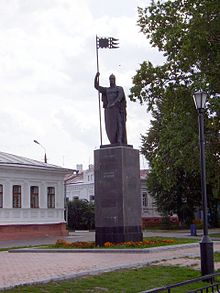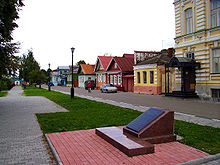- Gorodets
-
For other uses, see Gorodets (disambiguation).
Coordinates: 56°39′N 43°29′E / 56.65°N 43.483°E
 Coat of arms of Gorodets
Coat of arms of Gorodets
Gorodets (Russian: Городе́ц) is a town and the administrative center of Gorodetsky District of Nizhny Novgorod Oblast, Russia, located on the left bank of the Volga River, 53 kilometers (33 mi) northwest of Nizhny Novgorod. Population: 30,699 (2010 Census preliminary results);[1] 32,442 (2002 Census);[2] 34,210 (1989 Census);[3] 34,000 (1970).
In the past, the town was also sometimes referred to as Gorodets-Radilov (Городе́ц-Ради́лов), or simply Radilov.
Contents
History
A monument to Alexander Nevsky
Gorodets was founded in 1152 by Prince Yury Dolgoruky (also the founder of Moscow) as a large fortress on the Volga River, the first Russian fortress in today's Nizhny Novgorod Oblast. It was a starting point for numerous campaigns of the princes of Vladimir and Suzdal against Volga Bulgaria. In 1216, George II of Vladimir was dethroned by his brother and exiled here. In 1239, the town was burnt to the ground by Batu Khan's army. Folk tradition identifies Gorodets with Little Kitezh, a legendary town destroyed by the Mongols.
In 1263, Alexander Nevsky died in Gorodets on his way back to Novgorod from the Golden Horde. His son Andrew III made the town his chief residence. A famous medieval icon-painter, Prokhor, was born there. In the mid-14th century, the town was overshadowed by the neighbouring Nizhny Novgorod but continued as the third largest town of Nizhny Novgorod Principality until 1408, when Edigu razed it to the ground.
For two following centuries the town was known as Gorodets Pustoy (i.e., "Gorodets the Empty"). Some chronicles state that its entire population moved slightly downstream and resettled at Salt-on-Gorodets (today's Balakhna). By the 19th century, Gorodets was revived as a prosperous village settled by Old Believer merchants and reputed for its decorative handicrafts, such as wood carving and painting.
In 1875, the Nizhny Novgorod writer A. S. Gatsisky describes Gorodets as a major center of trade in grain and wooden kitchenware.[4]
In 1922, Gorodets becomes a town again, as well the administrative center of Gorodetsky Uyezd (later, Gorodetsky District). Between 1948 and 1959, the dam of Gorky Hydroelectric Station (now Nizhny Novgorod Hydroelectric Station) was built a few kilometers upstream from Gorodets, and along with the station a new industrial town, Zavolzhye, was built on the right side of the Volga.
Landmarks
 Our Lady of Kazan Church, Gorodets
Our Lady of Kazan Church, Gorodets
The chief historic monuments of Gorodets—the Trinity Cathedral (1644), St. Nicholas Church (1672), and Feodorovsky Monastery, associated with the famous icon of the same name—were destroyed by the Communists. The oldest surviving structure is a rather plain church (1707–1712), built over the site of an earlier church where the town's best known ruler, Andrew III, was interred in 1304.
There are several museums in the town, including: the Gingerbread Museum and the Samovar Museum; the latter housing a large collection of tea kettles.
Economy and transport
Besides sharing the Nizhny Novgorod Hydroelectric Station with Zavolzhye, Gorodets has a shipbuilding industry. Traditional local crafts — woodworking, embroidery, honey bread baking — are still pursued in Gorodets, but in a more industrial way, at several local factories, whose products are available at souvenir shops all over the country.
The electric railroad branch from Nizhny Novgorod ends in Zavolzhye; but there is a road connection over the hydro dam, which provides the only fixed crossing across the Volga between Nizhny Novgorod and Kineshma.
External links
- (Russian) History and monuments of Gorodets Radilov
- (Russian) Frescoes in the Church of Intercession of Out Lady, Gorodets
- (Russian) Volzhsky Perekrestok A Gorodets literary and historical Internet site.
- (Russian) Gorodetskaya Rospis: Decorated wooden goods from Gorodets
Footnotes
- ^ Федеральная служба государственной статистики (Federal State Statistics Service) (2011). "Предварительные итоги Всероссийской переписи населения 2010 года (Preliminary results of the 2010 All-Russian Population Census)" (in Russian). Всероссийская перепись населения 2010 года (All-Russia Population Census of 2010). Federal State Statistics Service. http://www.perepis-2010.ru/results_of_the_census/results-inform.php. Retrieved 2011-04-25.
- ^ Федеральная служба государственной статистики (Federal State Statistics Service) (2004-05-21). "Численность населения России, субъектов Российской Федерации в составе федеральных округов, районов, городских поселений, сельских населённых пунктов – районных центров и сельских населённых пунктов с населением 3 тысячи и более человек (Population of Russia, its federal districts, federal subjects, districts, urban localities, rural localities—administrative centers, and rural localities with population of over 3,000)" (in Russian). Всероссийская перепись населения 2002 года (All-Russia Population Census of 2002). Federal State Statistics Service. http://www.perepis2002.ru/ct/doc/1_TOM_01_04.xls. Retrieved 2010-03-23.
- ^ "Всесоюзная перепись населения 1989 г. Численность наличного населения союзных и автономных республик, автономных областей и округов, краёв, областей, районов, городских поселений и сёл-райцентров. (All Union Population Census of 1989. Present population of union and autonomous republics, autonomous oblasts and okrugs, krais, oblasts, districts, urban settlements, and villages serving as district administrative centers.)" (in Russian). Всесоюзная перепись населения 1989 года (All-Union Population Census of 1989). Demoscope Weekly (website of the Institute of Demographics of the State University—Higher School of Economics. 1989. http://demoscope.ru/weekly/ssp/rus89_reg.php. Retrieved 2010-03-23.
- ^ A Guide to Nizhny Novgorod and Nizhny Novgorod Fair Alexander Gatsisky, 1875. (Russian)
Cities and towns in Nizhny Novgorod Oblast Administrative center: Nizhny Novgorod 
 Categories:
Categories:- Cities and towns in Nizhny Novgorod Oblast
- Populated places on the Volga
- 1170s establishments
Wikimedia Foundation. 2010.


